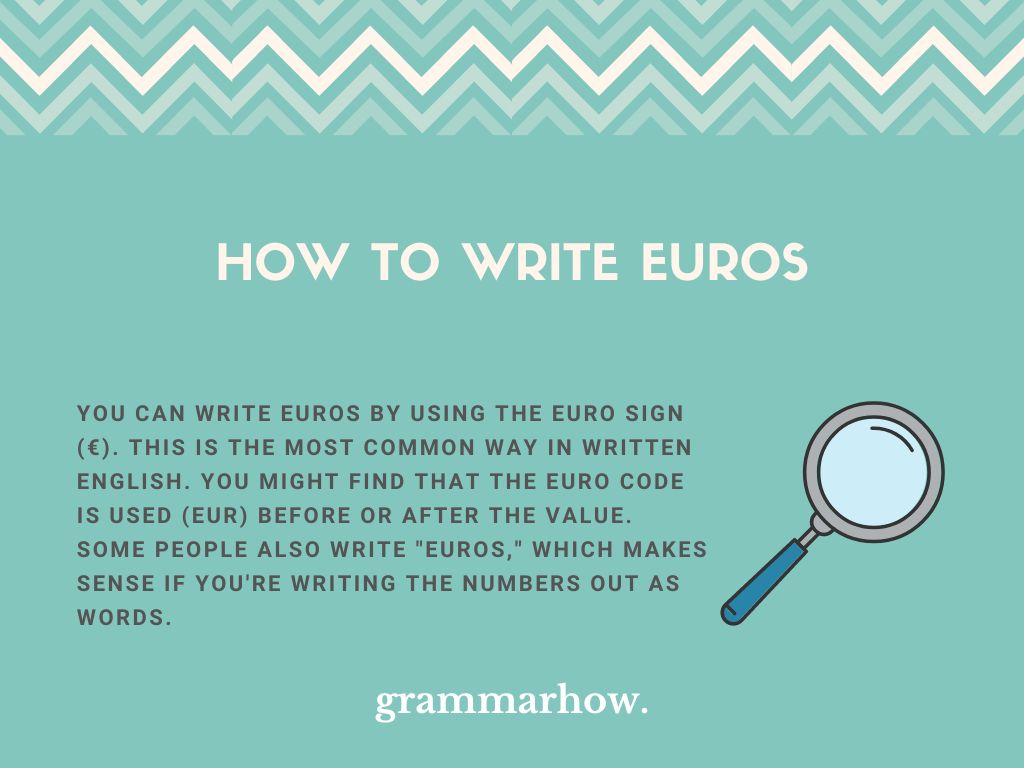Writing about euros can be tricky. When including numbers, letters, and symbols in the same piece of writing, you might be met with a few formatting styles that you need to know about. This article will explain all there is to know about writing euros.
How to Write Euros
You can write euros by using the euro sign (€). This is the most common way in written English. You might find that the euro code is used (EUR) before or after the value. Some people also write “euros,” which makes sense if you’re writing the numbers out as words.

Luckily, there are no exact rules that tell you what you can or can’t do. You’re free to make your own decisions based on whichever format you think looks best in your writing.
The only rule that you should stick with comes from consistency. If you decide on one style choice, it’s a good idea to stick with that one throughout your writing. Don’t keep switching between all of the different forms.
Using the Euro Sign
You can use the euro sign in your writing to show that euros are being used. This is fairly common in written English because the euro sign is easily identifiable. It’s similar to using the dollar sign ($) or the pound sign (£), which many native speakers recognize.
- If you’re going to ask me for €5, you can save your breath. I don’t have anything to share.
- I’m not going to spend another €100 on something like this. I don’t know why you’re even asking.
- She wanted 20€, but I didn’t have the time for her. I told her to leave immediately.
- I thought you wanted me to sort it with the €60 that I put aside for this.
Using the Euro Code
You can use the euro code (EUR) before or after the value in your writing. This is a fairly common way of writing the currency in financial contexts. It’s quite common for the euro code to be used with something like the stock market or in accounting.
- We wanted to share the EUR 500 that we won, but we weren’t sure if you would be around to take it.
- It was only EUR 60. It’s not much, but it’s enough for us to get by for a little while.
- She wanted to take 50 EUR with her to the event. I told her that might be a little bit too much.
- I thought it would be wise for us to take the 350 EUR with us. It’s worth doing at some point.
Using the Word
The word “euros” works well in many cases. You can use it with a number (i.e. 10 euros) or a written number (i.e. ten euros). Ideally, you should write out the number to make sure that it is all written out. This helps it to stay consistent and formal.
If you would rather use the number, there’s nothing wrong with that. “10 euros” still works just as well as “ten euros.” We recommend only using the mixture of a number and a word in informal English, though.
- I wanted her to spare five euros for the event, but she wasn’t giving me anything.
- Did you not say that it was supposed to be one thousand euros? I can’t afford that.
- It’s going to be 25 euros. I think that’s all it will cost, but I could be wrong.
- 1,500 euros is a bit much, but I’ll see what I can do.
How to Write Million Euros
You can write one million euros in a few ways. First, you can use the number and sign format, which would be €1,000,000. Secondly, you could use the euro code (either 1,000,000 EUR or EUR 1,000,000). Finally, you could just write “one million euros.”
With complicated numbers, you might be better off avoiding “one million euros.”
While it’s easy to say “one million,” things can get difficult to write out in that way when you’re using complicated numbers like 1,234,293. In this case, the sign or code works better.
Final Thoughts
There are many ways to write euros. All of them are correct, and it depends on your stylistic choice. Once you pick one, you should stick to it. You can use the euro sign (€), the euro code (EUR), or use the word “euros” alongside the number.
You may also like:
How Do You Say Dollar Amounts? (Full Explanation)
Euro Symbol Before or After the Number? (20€ or €20)
How to Write USD Amount in Words (Full Explanation)
Dollar Sign Before or After the Number? (20$ or $20)
How to Write Negative Currency in Text (Negative Money)
